The 2021 State of SaaSOps Report
September 30, 2021
7 minute read

We’re thrilled to announce the release of our 2021 State of SaaSOps report!
Since 2012, we’ve been surveying IT professionals and publishing research to better understand what the shift to SaaS means for IT, end users, and the broader organization. Every year we explore IT’s biggest challenges and concerns, trends in SaaS adoption, and what the future holds—making this the industry’s largest and longest running research of its kind.
This year’s survey of 523 IT and security professionals reveals the latest challenges of managing SaaS at scale, particularly as digital transformation catapulted forward in 2021—and IT kept the momentum going. It also sheds new light on SaaS file security, the state of SaaSOps automation, the workplace of the future, and more.
Here’s an excerpt from the report.
Key takeaways
- SaaS adoption continues to explode. The average organization uses 110 SaaS apps this year, up 38% from an average of 80 apps last year.
- More SaaS brings more SaaS management challenges. More than half of respondents (55%) say the top challenge to solve in their SaaS environment is lack of visibility into user activity and data. Additionally, nearly a third of respondents said they waste 20-39% of their total SaaS spend on unused or underutilized SaaS licenses.
- IT is facing new SaaS security concerns and challenges. This year, as SaaS file security violations spiked 134%, over half (55%) of respondents say their biggest security concern is not knowing where sensitive data exists.
- Every organization will eventually become a SaaS-Powered Workplace. SaaS has crossed the chasm. While many organizations are still in the early stages of their SaaS adoption journey, at some point, every organization will be powered by SaaS.
- Levels of SaaSOps automation will nearly double in the next three years. SaaS-Powered Workplaces report that today 45% of their routine SaaS operations is already automated and estimate it will rise to nearly 80% in three years.
- In response to the past year, IT’s role is becoming more strategic. 76% of respondents report being more or much more strategic over the last 12 months.
- The SaaSOps role will be critical to every IT team. All told, 60% of IT professionals already have “SaaSOps” in their job titles/descriptions or plan to add it in the future—a whopping 100% increase from last year.

SaaS adoption continues to explode, as organizations use an average of 110 SaaS apps in 2021
As organizations continue to embrace (and accelerate) their digital transformation journeys, SaaS adoption remains unabated. Up from an average of 80 apps last year, this year organizations use 110 apps, for a 38% increase. This is nearly a 7x increase in SaaS app usage since 2017, and almost a 14x increase since 2015.
The biggest SaaS management challenge? Lack of visibility
More SaaS brings more challenges.
The number one challenge according to our respondents is lack of visibility into all user activity and data. What data are users downloading, sharing, exporting, and forwarding? What apps are employees using?
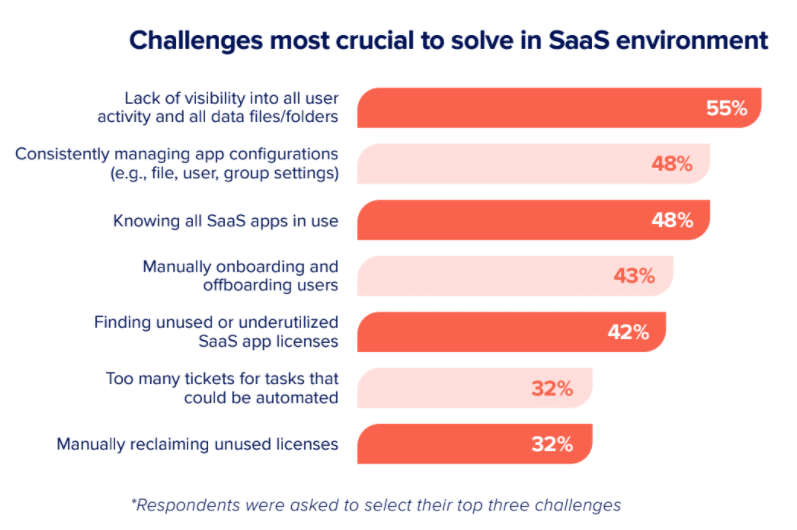
Without visibility and actionable insights into their SaaS environment, IT is flying blind. And as SaaS adoption continues to massively climb, these challenges only compound.
Lack of visibility results in wasted SaaS spend
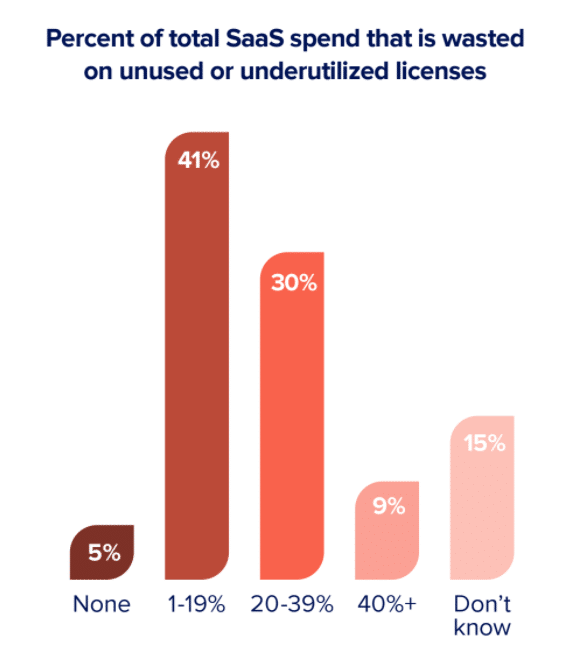
Forty-two percent of respondents said finding unused or underutilized SaaS app licenses was one of their most crucial challenges to solve. And indeed, 80% of respondents concede that some percentage of their SaaS spend is being wasted.
License waste comes in many flavors. It could be the apps that go unloved and unused. It could be similar apps solving the same use case, like having six different project management apps across the business. It could be different departments using the exact same app, only with different accounts. In all of these cases, there are massive untapped opportunities to cut costs and properly allocate licenses. But without visibility, it’s incredibly difficult to identify these opportunities.
So how much of total SaaS spend is wasted on unused or underutilized SaaS licenses? Nearly a third said between 20-39%—which can mean thousands (or even millions) of dollars, depending on your SaaS spend.
Top SaaS security concerns: not knowing where sensitive data lives, unsanctioned apps, and more
The biggest security concern plaguing IT when it comes to SaaS is not knowing where sensitive data exists. If you don’t know where your data resides, you can’t protect it.
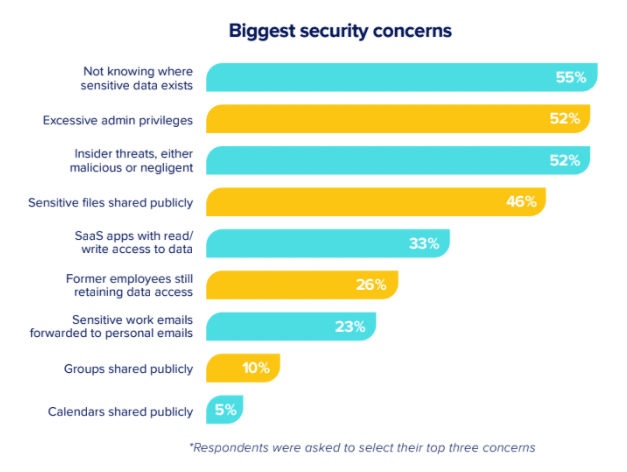
Additionally, it’s never been easier for end users to procure and deploy SaaS by themselves. Nearly three-quarters (69%) of our respondents worry about unsanctioned SaaS apps creating security issues.
This year SaaS file security violations have spiked 134%, and the number of files containing PII has grown 1944% year over year.
SaaS cuts both ways. While SaaS is a gamechanger for productivity, it also gives employees new levels of control over critical company assets. And with this new control come new risks related to app misconfigurations, excessive permissions, and uncontrolled file sharing.
The well-meaning but negligent employee poses the biggest data loss threat—by far
According to our respondents, the greatest risk to data loss isn’t the hoodie-wearing hacker or disgruntled employee.

Overall, a whopping 72% of organizations feel that the greatest risk to data loss is the well-meaning employee who unwittingly shares sensitive information. These employees have good intentions and are just trying to do their jobs, but often lack the training or knowledge to keep sensitive information safe.
Employees who are merely trying to get work done or circumvent friction may share data publicly across the organization (or even publicly on the internet) without realizing the implications of their actions. Because they have access to confidential data and systems, it’s critical to implement thoughtful and thorough security training and develop a healthy security culture.
Every organization will eventually become a SaaS-Powered Workplace
As SaaS adoption continues to reach dizzying heights, a new type of workplace has clearly emerged: the SaaS-Powered Workplace. These are organizations that are running almost entirely on SaaS. But of course, not every organization is as reliant on SaaS yet. Three segments stood out in our study, all with varying levels of SaaS maturity, which illustrate how the digital workplace is evolving:

Many organizations are still in the early stages of their SaaS adoption journey. But the data clearly reveals that they too are trending in the same direction as SaaS-first workplaces. SaaS has crossed the chasm—and at some point, every organization will become a SaaS-Powered Workplace.
Levels of SaaS automation will nearly double in the next 3 years
Given how time consuming it is to manage manual work, wrangle SaaS sprawl, and secure data, IT teams are increasingly turning to automation. The top benefit that IT teams expect from automating SaaS management? Improved operational efficiency.

SaaS automation will make big gains over the next few years. SaaS-Powered Workplaces report that today 45% of their routine SaaS operations is already automated and estimate it will rise to nearly 80% in three years. Workplaces in Transition and Traditional Workplaces, too, expect to double their automation levels.
Any organization adopting SaaS will eventually face the same operational challenges that come with discovering, managing, and securing SaaS apps, users, and files at scale. As SaaS apps proliferate, IT is beset with more and more manual tasks. And as SaaS-Powered Workplaces have learned, automating SaaSOps is the only way to scale and create more capacity.
In 2021, IT’s role (finally) shifted from functional to strategic—and will continue growing in importance
Amid the accelerating pace of technology and explosion of SaaS adoption, IT is helping organizations address new challenges and evolving its role from ticket taker to tech enabler. To continue driving momentum and enabling their modern workforces, IT changed to think strategically—as 76% told us.
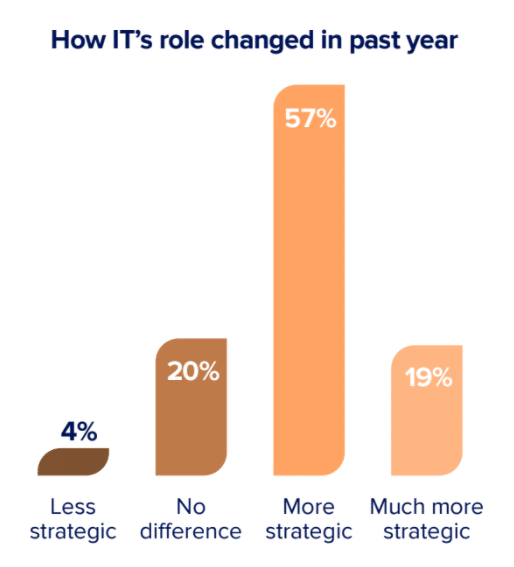

In the past year, they’ve become less reactive, more proactive. They’re participating in strategic planning, driving customer outcomes, and becoming trusted strategic partners to the business, ultimately leading the way to tomorrow’s workplace.
The SaaSOps role will be critical to every IT team
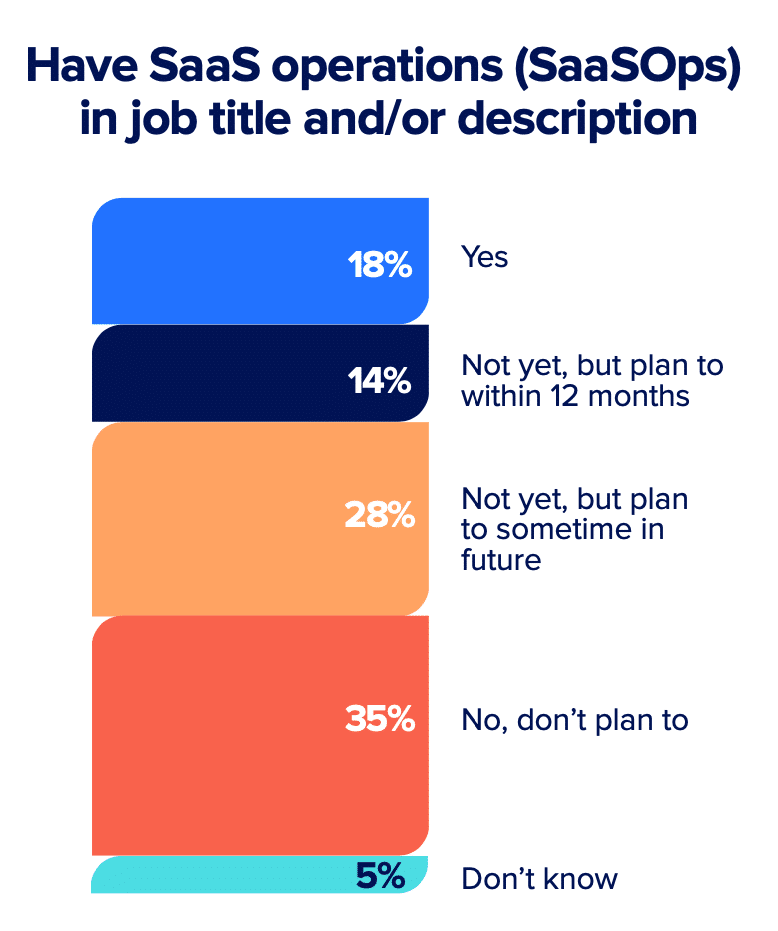
Additionally, SaaSOps is increasingly influencing the evolution of job titles. All told, 60% of IT professionals already have “SaaSOps” in their job titles/descriptions or plan to add it in the future—a whopping 100% increase from last year. For many respondents, SaaSOps is where they’ll realign their career goals, if they haven’t started to already.
Workplaces in Transition and Traditional Workplaces are more established organizations with legacy infrastructure—and they, too, recognize the need to hire for SaaSOps roles and skills.
The future of SaaSOps is now.
Download the full report to learn:
- The current state of SaaS adoption across organizations of all sizes
- The top five most common types of sensitive data stored in cloud apps
- File sharing settings benchmarking metrics by industry
- The strategic projects your peers are working on by automating more
- The future of SaaSOps
- And more
Regardless of whether you’re a SaaS-Powered Workplace, Workplace in Transition, or Traditional Workplace, download the report and see how you compare.
To learn more about how BetterCloud can help you discover, manage, and secure your SaaS environment, request a demo.





